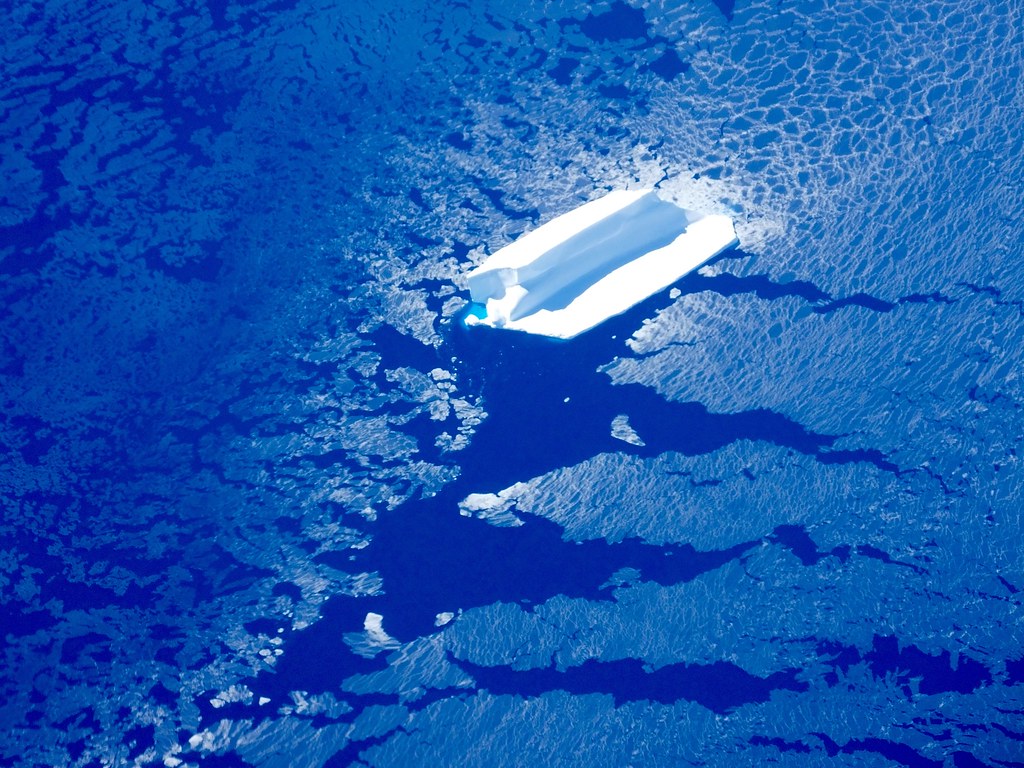Featured Image: Iceberg floating through thin sea ice. Image courtesy NASA ICE, used with permission.
Authors: Ulrike Braeckman, Francesca Pasotti, Ralf Hoffmann, Susana Vázquez, Angela Wulff, Irene R. Schloss, Ulrike Falk, Dolores Deregibus, Nene Lefaible, Anders Torstensson, Adil Al-Handal, Frank Wenzhöfer, Ann Vanreusel
Nothing compares to the ethereal beauty of a clear lake. Looking down, you can see a whole world flourishing below: plants, fish, and critters. Compare that to a cloudy, or turbid, lake and suddenly you may feel very small, worried about what’s lurking beneath you. New research shows that the Antarctic ocean is transitioning from clear to turbid water, with big implications for ocean ecosystems.
During a typical Antarctic winter, the ocean boasts these clear waters offshore. As shore fast and pack ice freezes, it blocks any runoff from nearby rivers or melting glaciers, keeping the water crystal clear. This clarity allows for plants and algae to thrive; both generate loads of oxygen. However, if the shore fast and pack ice does not form or is very sparse, or melts very early in spring, suddenly the runoff from melting glaciers plunges into the shallow ocean, mixing and clouding the water.
Braeckman and colleagues launched a multi-year investigation to understand how the Antarctic marine ecosystem changes as waters become more turbid during warm years. They showed that when the water is turbid, the offshore benthic (bottom-dwelling) marine communities no longer produce oxygen and instead likely contribute to greenhouse gas production.
Marine plants and algae produce oxygen through photosynthesis. In 2015, the West Antarctic Peninsula was very cold and experienced full formation of sea ice with virtually no glacial runoff, allowing for photosynthesis and oxygen production that benefits the whole benthic community. However, in 2016, the same area experienced three-times greater glacial runoff compared to previous years, no snow accumulation, and very little sea ice. This runoff mobilizes ocean sediments and delivers large amounts of glacial flour, or fine sediment. The lack of sea ice also provides a highway for floating icebergs which grind across the seafloor, devastating plant and animal communities. During this year, Braeckman and colleagues detected only 3 days-worth of oxygen production over the course of a year compared to approximately 90 days (3 months) in 2015.
If a whole ecological community produces more oxygen via photosynthesis than they produce carbon dioxide, the community is said to be autotrophic. Conversely, communities that consume oxygen (much like how we breathe oxygen) are heterotrophic. In order to understand community autotrophy, scientists can measure the rate at which the algae and plants grow and accumulate biomass. Lumping these measurements together equals a metric known as “net primary production”, or NPP. Changes in a community’s NPP cause immediate and potentially devastating changes to the plants and animals that may rely on the oxygen to breathe and plant matter to eat.
Interestingly, previous studies of similar environments have shown that input of glacial flour actually stimulates photosynthesis by providing rare nutrients necessary for oxygen production. However, Braeckman and colleagues’ work showed that these effects are likely limited below five meters water depth as their study encompasses the entire biological community down to the sea floor.
As our planet continues to warm, less sea ice will form, inland glaciers will continue to melt at an increased rate, and icebergs will more frequently bulldoze benthic communities. The ecosystem shift captured by Braeckman and coworkers is becoming more widespread in our warming world. The full implications of these community shifts are still a mystery, but we can say with certainty that sustained heterotrophic conditions of these fragile ecosystems are now likely contributing to climate change as the absence of sea ice is increasing ocean turbidity and blocking photosynthesis.
Antarctic seafloor oxygen is diminishing–and glaciers may be to blame by Jessica Buser-Young is licensed under a Creative Commons Attribution-ShareAlike 4.0 International License.

